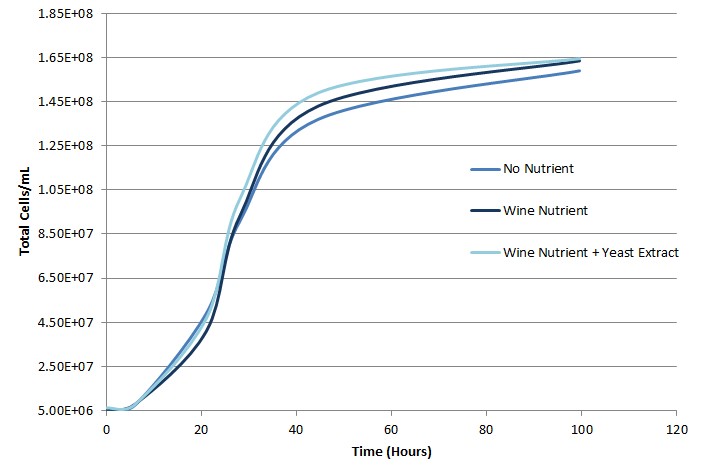Managing Low Nitrogen Fermentations with Supporting Fermentation Products

Wine and wine-like fermentations (cider, mead, and seltzer) often require significant supplementation of yeast assimilable nitrogen (YAN) to avoiding poor fermentation kinetics and off-odor development. A measurable YAN value of 140 mg N/L has been reported as a minimum limit for avoiding stuck fermentations in wine musts of standard sugar concentration.1 Surveys have shown that YAN in wine and wine-like musts vary widely, with apple, honey, and hard seltzer musts typically containing YAN levels below the minimum limit.
| Fermentation |
Average YAN (mg N/L) |
| Wine |
213 |
| Cider |
56 |
| Mead |
50 |
| Hard Seltzer |
0 |
Table 1: Reported average YAN content of wine2, cider3, mead4, and hard seltzer musts.
Measurement of primary amino nitrogen and free ammonium ions in a solution of Wyeast Wine Nutrient Blend and Wyeast Yeast Extract has revealed the exact YAN contribution of the products. At the current suggested dosage rate of 8.9 g/hL, Wyeast Wine Nutrient Blend provides 11.5 mg N/L of measurable YAN. While this suggested dosage rate will provide adequate amounts of micronutrients and growth factors, additional nitrogen may be needed.
For fermentations containing exceptionally low amounts of YAN, supplementing musts with both Wyeast Wine Nutrient and Wyeast Yeast Extract is recommended. Wyeast Yeast Extract contributes 5 mg N/L of measurable YAN at the suggested dosage rate of 12 g/hL. Additionally, the majority of the YAN in Wyeast Yeast Extract is organic nitrogen, which has been shown to provide improved fermentation kinetics and flavor profiles in finished wines compared to inorganic nitrogen sources such as diammonium phosphate.5
The best practice for managing low YAN fermentations is to begin by measuring the initial YAN concentration. Based on the starting YAN and the objectives of the fermentation, a nutrient addition plan can be developed. Wyeast Wine Nutrient Blend should be used at the suggested dosage rate while adjusting the dosage rate of Wyeast Yeast Extract can assure the minimum threshold of YAN is achieved.
To demonstrate effects of these nutrients in low YAN fermentations, pear juice concentrate was reconstituted to 14.5 Brix and supplemented with either no nutrients, Wyeast Wine Nutrient at 8.9 g/hL, or both Wyeast Wine Nutrient at 8.9 g/hL and Wyeast Yeast Extract at 120 g/hL. Fermentations were conducted in duplicate at 21oC after inoculation of Wyeast 4021 Dry White/Sparkling at 5.00×106 cells/mL. As shown below, fermentations which received both Wyeast Wine Nutrient and Wyeast Yeast Extract reached maximum cell populations and terminal gravity faster than fermentations which received no nutrients or only Wyeast Wine Nutrient. The additional 50 ppm YAN provided by the Yeast Extract was sufficient for improving cell growth and fermentation kinetics compared to fermentations which received only the Wine Nutrient.
Figure 1: Change in total cell counts during pear juice fermentations.
Figure 2: Density change during pear juice fermentations.
- Bell, S. and Henschke, P.A. (2005) Implications of nitrogen nutrition for grapes, fermentation and wine. Australian Journal of Grape and Wine Research 11:242–295.
- Butzke, C.E. (1998) Survey of Yeast Assimilable Nitrogen Status in Musts from California, Oregon, and Washington. American Journal of Enology and Viticulture 49:220-224.
- Boudreau, T.F.; Peck, G.M.; O’Keefe, S.F.; Stewart, A.C. (2017) Free amino nitrogen concentration correlates to total yeast assimilable nitrogen concentration in apple juice. Food Science and Nutrition 6(1): 119-123.
- Pereira, A.P.; Mendes-Ferreira, A.; Oliveira, J.M.; Estevinho, L.M.; Mendes-Faia, A. (2013) High-cell-density fermentation of Saccharomyces cerevisiae for the optimization of mead production. Food Microbiology 33: 114-123.
- Torrea, D.; Varela, C.; Ugliano, M.; Ancin-Azpilicueta, C.; leigh Francis, I.; Henschke, P.A. (2011) Comparison of inorganic and organic nitrogen supplementation of grape juice – Effect on volatile composition and aroma profile of a Chardonnay wine fermented with Saccharomyces cerevisiae yeast. Food Chemistry 127(3): 1072-1083.


